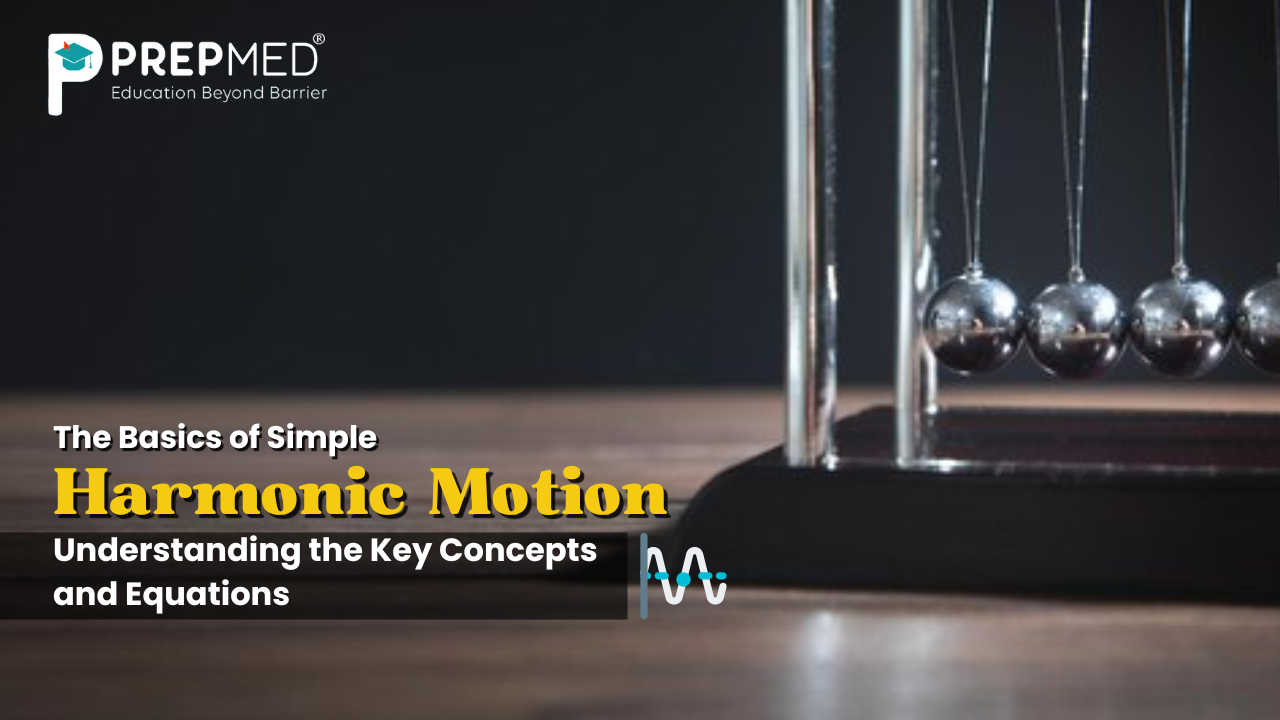January 12, 2025
The Basics of Simple Harmonic Motion: Understanding the Key Concepts and Equations
A Simple Harmonic Motion is a motion that results in an oscillation characterized by a force which is directly proportional to the displacement of a body from its mean position. This restoring force is always directed toward the mean position. Acceleration is defined as a particle undergoing simple harmonic motion by a(t)=-ω2 x(t). Here ω represents the particle's angular velocity.
Simple Harmonic Motion, or SHM, is a concept in physics that deals with the oscillatory motion of objects. It is a fundamental topic in mechanics, incorporated in different physical applications, such as a mass-spring system or a swinging pendulum. In this article, the reader will learn the fundamental concepts of SHM, the conceptual ideas, and the equations that describe the motion.
What do you mean by Simple Harmonic Motion?
Simple harmonic motion is the directional to and fro vibration of an object about a centrally located point of rest where the horizontally acting force is directly proportional to the amount of displacement from this center. In other words, it explains vibrations in contexts where the restoring force that returns the object to its equilibrium position is directly proportional to the extent to which it is displaced.
Simple harmonic motion is most easily described with the help of two main examples: oscillation of a spring mass system and swinging of a simple pendulum, therefore its formula has good applicability. SHM can also be described as a special example of oscillatory motion and since the graph of periodic motion is in the form of a sinusoidal waveform, it can be described by sine and cosine functions.
What do you mean by Periodic motion, Oscillatory motion, and Harmonic Motion?
Periodic Motion- The motion in which a particle returns to the same position and state after equal intervals of time is called periodic motion Examples: motion of a simple pendulum.
Oscillatory Motion- A periodic motion that occurs in to and fro or back and forth about a particular point e.g. motion of a loaded spring.
Harmonic Motion- When oscillation can be described using a single harmonic function, for example sine or cosine, then it is referred to as harmonic oscillation.
Understanding the key concepts in SHM
To study SHM, there are some key concepts and quantities essential to define. These are; the amplitude, the frequency, period, angular frequency, displacement velocity, acceleration, phase, and restoring force. Let’s explore each in detail:
Amplitude (A):
This is the maximum distance that the oscillating object goes through from the equilibrium position. It shows the maximum displacement of the motion in the oscillation cycle and also the maximum displacement per unit time. It is measured in meters (m).
Frequency (f):
Frequency is defined as the number of full oscillations or cycles that are completed in one second. Frequency’s unit is Hertz (Hz), where 1 Hz represents one oscillation per second. Here, it is connected to the period of motion of the situation.
Period (T):
The period is described as the amount of time that is taken within the completion of one cycle of oscillation of an object. It is the inverse of frequency and it is measured in seconds The symbol used is (s). Mathematically, the period T is given by:
T=1/f
Displacement (x):
Displacement is the measurement of the extent of a change in an object's position in relation to its equilibrium condition at any particular time. In the case of SHM displacement is a function of time and it oscillates sinusoidally while the body is moving forward and backward.
Velocity (v):
The velocity of an object moving in SHM can be defined as the rate of change of displacement with respect to time. It also varies sinusoidally, but its maximum value is obtained when displacement is at its minimum; that is, at equilibrium position z=0.
Acceleration (a):
Acceleration in SHM is defined as the rate of change of velocity with respect to time and is directly proportional to the displacement but the direction is opposite.
a=−ω2x
ω represents angular frequency, and displacement is represented by x.
Restoring Force (F):
The restoring force on the other hand is defined as the force that tends to restore the object to its position of equilibrium. From Hooke Law, the restoring force is directly proportional to the displacement.
F=−kx
where the spring constant is k, and x represents the displacement.
The key Equations of Simple Harmonic Motion
The oscillation of an object oscillating in SHM can be modelled using certain equations that link displacement, velocity, acceleration, and force. These equations are obtained from Newton’s Second Law of motion and Hooke’s Law of elasticity.
- Equation of Motion: The basic equation of motion for simple harmonic motion are as follows:
F=−kx
This equation implies that the force required to restore the object to its original position is directly proportional to the object’s displacement while the direction of force is in the opposite direction. From Newton’s second law, F= ma, we can write the equation as
ma=−kx
- Displacement as a Function of Time: The solution of the differential equation can provide an expression of the displacement of the object with respect to time.
x(t)=Acos(ωt+ϕ)
Where:
A is the motion’s amplitude,
ω represents the angular frequency (represented by ω=2πf),
ϕ is the phase constant, which determines the initial conditions of the motion.
- Velocity as a Function of Time: The velocity of the object can be found by differentiating the displacement equation with respect to time:
v(t)=−Aωsin(ωt+ϕ)
- Acceleration as a Function of Time: Similarly, the acceleration can be obtained by differentiating the velocity equation:
a(t)=−Aω2cos(ωt+ϕ)
- Energy in SHM: In SHM, the total mechanical energy is conserved as long as zero damping is involved during the oscillation. The total energy is the sum of kinetic and potential energy:
E=1/2kA2
- Angular Frequency (ω): Angular frequency plays a role in connection with the frequency of oscillation and the mass as well as the spring constant which is applicable to a mass-spring system. It is defined as:
w=√k/m
Where m is the mass of the object, and k is the spring constant.
FAQS:
- What is the relevance of SHM in physics?
The SHM is an analytical tool to study oscillatory systems and plays an indispensable role in areas such as mechanical vibrations, electrical circuits, sound waves or even in relation to atomic and molecular vibrations. It contributes to the understanding of many natural occurrences and acts as a framework for understanding various complex models of motions.
- How does the damping affect the motion in simple harmonic motion?
Damping is the rate at which oscillating energy in an oscillating system is dissipated to the external forces such as friction or air resistance. Although the SHM does not consider energy dissipation, actual structures are damped and therefore vibrate with an amplitude that gradually decreases until the motion stops.
- How can you determine the period and the frequency of the simple harmonic motion?
The period (T) of SHM is the time required by an object to complete one complete oscillation and is calculated by: T=1/f
The frequency (f) is the number of oscillations per second, and it is the inverse of the period: f=1/T







